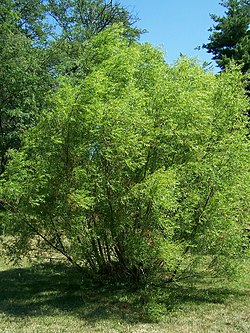Salix nigra
| Height: | ⇕ | 10 ft"ft" can not be assigned to a declared number type with value 10. to 30 ft"ft" can not be assigned to a declared number type with value 30. |
|---|---|---|
| Width: | ⇔ | 15 ft"ft" can not be assigned to a declared number type with value 15. |
| Lifespan: | ⌛ | perennial |
| Origin: | ✈ | E United States |
| Bloom: | ❀ | early spring, mid spring, late spring |
| Exposure: | ☼ | sun |
|---|---|---|
| Water: | ◍ | wet, moist |
| Features: | ✓ | flowers |
| USDA Zones: | 4 to 10 |
|
Salix > |
nigra > |
Marshall > |
Salix nigra (Black Willow) is a species of willow native to eastern North America, from New Brunswick and southern Ontario west to Minnesota, and south to northern Florida and Texas.[1]
It is a medium-sized deciduous tree, the largest North American species of willow, growing to 10-30 m tall, exceptionally up to 45 m, with a trunk 50–80 cm diameter. The bark is dark brown to blackish, becoming fissured in older trees. The shoots are slender, variable in color from green to brown, yellow or purplish; they are (like the related European Salix fragilis) brittle at the base, snapping evenly at the branch junction if bent sharply. The foliage buds are small, 2–4 mm long, with a single pointed reddish-brown bud scale. The leaves are alternate, long, thin, 5-15 cm long and 0.5-2 cm broad, usually somewhat falcate, dark, shiny green on both sides or with a lighter green underside, with a finely serrated margin, a short petiole and a pair of small stipules. It is dioecious, with small, greenish yellow to yellow flowers borne on catkins 2.5-7.5 cm long in early spring at the same time as the new leaves appear. The fruit is a 5 mm capsule which splits open when mature to release the numerous minute, down-covered seeds. It is typically found along streams and in swamps.[2][3][4]
Salix gooddingii (Goodding's Willow) is sometimes included in S. nigra as a variety, as S. nigra var. vallicola Dudley; when included, this extends the species' range to western North America. However, the two are usually treated as distinct species.[5]
Read about Salix nigra in the Standard Cyclopedia of Horticulture
|
|---|
|
Salix nigra. Black Willow. Tree, 30-40 ft. high: bark flaky, often becoming shaggy: twigs brittle at base: buds small: lvs. lanceolate, green both sides, finely and evenly serrate: aments 1-2 in. long; scales oblong, deciduous; stamens 3-6; ovary ovate-conical, glabrous; style short but distinct. E. N. Amer. Var. falcata, Pursh. Lvs. elongated, narrow and falcate.
|
Cultivation
Propagation
Pests and diseases
Varieties
Gallery
References
- ↑ Germplasm Resources Information Network: Salix nigra
- ↑ Tree Species of the World's Boreal Forests: Salix nigra
- ↑ Trees of the North Carolina Piedmont: Salix nigra
- ↑ New Brunswick tree and shrub species of concern: Salix nigra
- ↑ USDA Plants Profile: Salix gooddingii
- Standard Cyclopedia of Horticulture, by L. H. Bailey, MacMillan Co., 1963
External links
- w:Salix nigra. Some of the material on this page may be from Wikipedia, under the Creative Commons license.
- Salix nigra QR Code (Size 50, 100, 200, 500)

